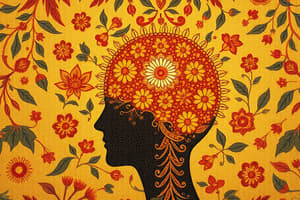Podcast
Questions and Answers
What concept explains why some individuals enjoy engaging in activities that induce fear, such as rollercoasters?
What concept explains why some individuals enjoy engaging in activities that induce fear, such as rollercoasters?
- Cognitive dissonance theory
- Self-actualization theory
- Arousal theory of motivation (correct)
- Instinct theory
Which statement about eating disorders is correct?
Which statement about eating disorders is correct?
- Individuals with anorexia nervosa typically recognize their problem.
- Individuals with bulimia nervosa are unaware of their condition.
- Individuals with bulimia may acknowledge their eating problems. (correct)
- Both disorders are solely based on biological needs.
In the context of consciousness, what does 'pre-conscious level' refer to?
In the context of consciousness, what does 'pre-conscious level' refer to?
- Mental activities that occur while sleeping
- Mental activities that are inaccessible to awareness
- Mental activities currently being realized by the individual
- Mental activities that can quickly become conscious (correct)
What does the concept of dualism propose about the mind and brain?
What does the concept of dualism propose about the mind and brain?
Which of the following needs replaced self-actualization in the revised model of Maslow's hierarchy?
Which of the following needs replaced self-actualization in the revised model of Maslow's hierarchy?
Which approach emphasizes that behavior is primarily shaped by biological processes such as hormones and genes?
Which approach emphasizes that behavior is primarily shaped by biological processes such as hormones and genes?
Who is known for establishing the first research laboratory in psychology in 1879?
Who is known for establishing the first research laboratory in psychology in 1879?
What principle is primarily associated with B.F. Skinner's explanation of behavior?
What principle is primarily associated with B.F. Skinner's explanation of behavior?
Which psychological approach is characterized by its focus on observable behavior and learning from past experiences?
Which psychological approach is characterized by its focus on observable behavior and learning from past experiences?
Which of the following best describes the psychodynamic approach to psychology?
Which of the following best describes the psychodynamic approach to psychology?
Which approach asserts that human behavior is shaped by individual perceptions and the choices they make?
Which approach asserts that human behavior is shaped by individual perceptions and the choices they make?
Which psychological perspective challenges the notion that some knowledge is innate?
Which psychological perspective challenges the notion that some knowledge is innate?
What is the primary focus of the cognitive approach in psychology?
What is the primary focus of the cognitive approach in psychology?
Which structure in the hindbrain is responsible for controlling fine movements and coordinating cognitive processes?
Which structure in the hindbrain is responsible for controlling fine movements and coordinating cognitive processes?
What role does the hypothalamus play in the forebrain?
What role does the hypothalamus play in the forebrain?
Which neurotransmitter is primarily involved in memory and movement?
Which neurotransmitter is primarily involved in memory and movement?
The amygdala is mainly associated with which of the following functions?
The amygdala is mainly associated with which of the following functions?
What is the primary role of the endocrine system?
What is the primary role of the endocrine system?
Which statement about the role of the endocrine system is correct?
Which statement about the role of the endocrine system is correct?
What is the main function of serotonin in the neurotransmitter system?
What is the main function of serotonin in the neurotransmitter system?
Which of the following best describes the main function of the nervous system?
Which of the following best describes the main function of the nervous system?
Which neurotransmitter is primarily responsible for slowing down brain activity?
Which neurotransmitter is primarily responsible for slowing down brain activity?
The corpus callosum is responsible for which of the following functions?
The corpus callosum is responsible for which of the following functions?
Which disorder is associated with the dysfunction of dopamine?
Which disorder is associated with the dysfunction of dopamine?
What structure connects the endocrine system with the control of hormone secretion?
What structure connects the endocrine system with the control of hormone secretion?
What is the term for a group of neurons that use the same neurotransmitter?
What is the term for a group of neurons that use the same neurotransmitter?
Which system carries messages between the central nervous system and involuntary organs?
Which system carries messages between the central nervous system and involuntary organs?
Which of the following pairs is correctly matched in terms of function and structure?
Which of the following pairs is correctly matched in terms of function and structure?
What is the definition of sensation?
What is the definition of sensation?
What is the primary focus of neuropsychology?
What is the primary focus of neuropsychology?
Which model suggests that psychological disorders emerge from the interaction of predispositions and stress?
Which model suggests that psychological disorders emerge from the interaction of predispositions and stress?
What does the DSM stand for in mental health?
What does the DSM stand for in mental health?
Which statement is true regarding the medical model of psychological disorders?
Which statement is true regarding the medical model of psychological disorders?
What distinguishes clinical neuropsychologists from other neuropsychologists?
What distinguishes clinical neuropsychologists from other neuropsychologists?
Which of the following best describes the biopsychosocial approach?
Which of the following best describes the biopsychosocial approach?
Which psychological treatment method emphasizes insight through understanding unconscious thoughts and emotions?
Which psychological treatment method emphasizes insight through understanding unconscious thoughts and emotions?
In the context of the three D's (deviance, distress, dysfunction), which aspect predominantly relates to maladaptive behavior?
In the context of the three D's (deviance, distress, dysfunction), which aspect predominantly relates to maladaptive behavior?
Flashcards are hidden until you start studying
Study Notes
Behaviorism
- John B Watson and B.F. Skinner are key figures in Behaviorism
- Focuses on observable behaviors and how the environment influences them
- Explains behavior using learning principles such as operant conditioning
- Emphasizes the relationship between behavior and environmental stimuli
Evolutionary Approach
- Darwin's theory of evolution by natural selection is a foundation for this approach
- Asserts that current animal and human behaviors are the result of evolutionary processes
- Suggests that adaptations developed to enhance survival and reproductive success
Psychodynamic Approach
- Centers on the idea that our behaviors and mental processes stem from internal, mostly unconscious, psychological conflicts
- Freud is a prominent figure in this approach
- Emphasizes the significance of unconscious drives and early childhood experiences in shaping personality and behavior
Cognitive Approach
- Focuses on the way we perceive, process, and store information
- Explores how cognitive processes affect our behavior
- Examines mental processes like thinking, remembering, and problem solving
Humanistic Approach
- Also known as the phenomenological approach
- Emphasizes our inherent capacity for self-determination and personal growth
- Posits that choices stem from our unique perceptions and not just biological drives or external rewards
Brain Divisions and Functions
- Hindbrain: Core functions like breathing, heart rate, and movement coordination are controlled by the cerebellum, medulla oblongata, and reticular formation.
- Midbrain: Responsible for sensory relay, automatic responses, and initiation of smooth movements
- Forebrain: Complex cognitive functions, emotions, memory formation, and sensory integration are controlled by structures like the amygdala, cerebral cortex, corpus callosum, hippocampus, hypothalamus, and thalamus
Neurotransmitters
- Chemical messengers that transmit signals between neurons
- Acetylcholine: Plays a crucial role in memory and movement, with its deficiency associated with Alzheimer's disease
- Norepinephrine: Influences mood, sleep, and learning, and its imbalance can lead to depression
- Serotonin: Regulates mood, appetite, and impulsivity, and its deficiency is linked to depression
- Dopamine: Involved in movement, reward, and motivation, with its dysfunction connected to Parkinson's disease and schizophrenia
- GABA: Functions as an inhibitory neurotransmitter associated with sleep and movement, and its imbalance can lead to anxiety and epilepsy
- Glutamate: An excitatory neurotransmitter implicated in memory and can cause brain damage during stroke
Endocrine System
- A network of glands that communicate through hormones released into the bloodstream
- Hormones provide feedback to the brain and pituitary gland, creating a negative feedback system
- Plays a vital role in regulating various functions from stress to physical growth
- The brain ultimately governs hormone secretion and controls stress reactions like "fight or flight"
Neurons and Neurotransmitters
- Key communication components within the human system
- Influence behavior and mental processes
- For neurons to communicate, neurotransmitters must cross the synapse separating them
Nervous System Function
- The primary functions of the nervous system include receiving, processing, and transmitting information
Nervous System Components
- Two cell types make up the nervous system: neurons and glial cells
- Peripheral Nervous System (PNS): Conveys sensory information from sense organs to the Central Nervous System (CNS) and carries signals back to muscles.
- Somatic Nervous System: Communicates sensory information to the CNS and carries signals to skeletal muscles.
- Autonomic Nervous System: Facilitates communication between the CNS and internal organs such as the heart, lungs, and glands
Brain Structure and Function
- The brainstem is the oldest part of the brain.
- Memory impairments seen in Alzheimer's disease are often linked to the shrinkage of the hippocampus.
- GABA (gamma-aminobutyric acid) is the primary neurotransmitter responsible for slowing or inhibiting brain activity.
- A group of neurons that share the same neurotransmitter is referred to as a neural pathway or neurotransmitter system.
- Glutamate can lead to brain damage during a stroke.
- The pituitary gland secretes adrenocorticotropic hormone (ACTH), which in turn stimulates the adrenal glands to release cortisol into the bloodstream
Sensation and Perception
- Sensation: Refers to the messages from the senses that provide raw information.
- Perception: Describes the process of giving meaning to sensory messages, occurring in a bottom-up manner
Motivation Theories
- Arousal Theory: Suggests that people are motivated to maintain an optimal level of arousal.
- Evolutionary Theories: Modern offshoots of theories based on instincts.
- Incentive Theories: Emphasize that the value of incentives is influenced by biological, social, and cognitive factors.
- Biological Theories: Acknowledge that biological needs play a role in motivation, but they also acknowledge that other factors contribute to eating behavior.
- Social Theories: Eating disorders, such as bulimia and anorexia, are influenced by social factors.
- Cognitive Theories: We experience motivation when we perceive a discrepancy between our current situation and our desired situation.
- Maslow's Hierarchy of Needs: This theory suggests a hierarchy of needs, with self-actualization at the top. Some modern revisions replace self-actualization with needs such as finding a mate, keeping a mate, and becoming a parent.
Consciousness
- Awareness of both external stimuli and our own mental activity.
- Dualism: A philosophical perspective proposing that the mind and brain are distinct entities.
- Materialism: A contrast to dualism, suggesting that the mind and brain are one and the same.
- Theatre View: The idea that consciousness is a single phenomenon, like a stage.
- Parallel Distributed Processing: The notion that the mind processes information across numerous parallel streams, with their interactions creating the experience of consciousness.
- Stream of Consciousness: William James's view of consciousness as a constantly flowing and changing stream.
Consciousness States
- Conscious Level: Mental activities we are normally aware of.
- Non-Conscious Level: Mental activity that is inaccessible to conscious awareness.
- Pre-Conscious Level: Mental activity that is not currently conscious but can be easily brought to our awareness.
Abnormal Psychology
- Sociocultural Factors: Influence what is considered abnormal.
- Abnormality: Often defined by deviance, distress, and dysfunction.
- Biopsychosocial Approach: Views mental disorders as arising from a combination of biological, psychological, and sociocultural factors.
- Medical Model (Neurobiological Model): Attributes mental disorders to disturbances in the anatomy or chemistry of the brain or other biological processes.
- Psychological Processes: Focuses on the role of psychological processes in the development of mental disorders.
- Diathesis-Stress Model: Suggests that a predisposition for a disorder, combined with sufficient stress, can trigger symptoms.
Psychotherapy Approaches
- Psychoanalysis: A method of psychotherapy that aims to provide insight through understanding unconscious thoughts and emotions.
- Humanistic Psychology: Emphasizes our capacity for conscious control and responsibility for our decisions.
- Cognitive Behavior Therapy (CBT): Learning-based treatment methods that help clients change both their thoughts and behaviors.
Neuropsychology
- The branch of psychology that investigates the relationship between brain processes, behavior, and psychological functioning.
- Neuropsychologists study how brain systems affect human abilities, including cognitive functions.
- Clinical Neuropsychologists: Use tests and methods to understand neuropsychological problems and intact functions in individuals.
- Brain Dysfunction Causes: Various factors contribute to brain dysfunction, including injuries, diseases, and genetic predispositions.
- Neuropsychological Disorders: Impact various aspects of human functioning, with specific symptoms and signs.
Studying That Suits You
Use AI to generate personalized quizzes and flashcards to suit your learning preferences.




